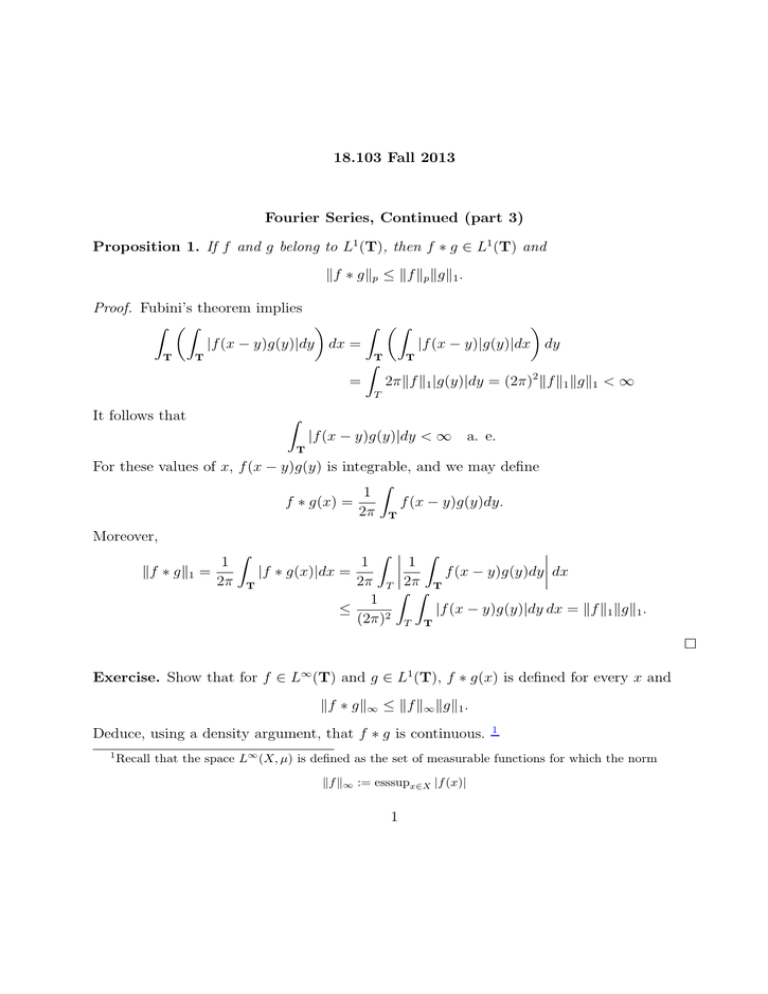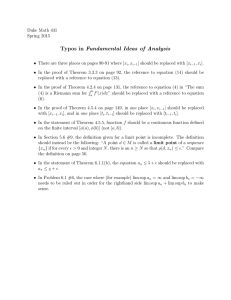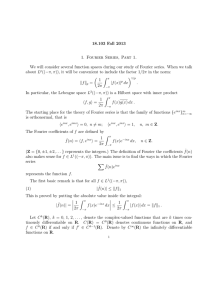18.103 Fall 2013 Fourier Series, Continued (part 3)
advertisement

18.103 Fall 2013
Fourier Series, Continued (part 3)
Proposition 1. If f and g belong to L1 (T), then f ∗ g ∈ L1 (T) and
kf ∗ gkp ≤ kf kp kgk1 .
Proof. Fubini’s theorem implies
Z Z
Z Z
|f (x − y)g(y)|dy dx =
|f (x − y)|g(y)|dx dy
T
T
T
T
Z
=
2πkf k1 |g(y)|dy = (2π)2 kf k1 kgk1 < ∞
T
It follows that
Z
|f (x − y)g(y)|dy < ∞ a. e.
T
For these values of x, f (x − y)g(y) is integrable, and we may define
Z
1
f (x − y)g(y)dy.
f ∗ g(x) =
2π T
Moreover,
1
kf ∗ gk1 =
2π
Z Z
1
1
dx
|f ∗ g(x)|dx =
f
(x
−
y)g(y)dy
2π T 2π T
T
Z Z
1
≤
|f (x − y)g(y)|dy dx = kf k1 kgk1 .
(2π)2 T T
Z
Exercise. Show that for f ∈ L∞ (T) and g ∈ L1 (T), f ∗ g(x) is defined for every x and
kf ∗ gk∞ ≤ kf k∞ kgk1 .
Deduce, using a density argument, that f ∗ g is continuous.
1
1
Recall that the space L∞ (X, µ) is defined as the set of measurable functions for which the norm
kf k∞ := esssupx∈X |f (x)|
1
Next, we introduce an operator notation for the Cesáro means of the Fourier series:
N
X
|n| ˆ
σN f (x) =
1−
f (n)einx = f ∗ FN (x),
N
n=−N
with FN the Fejér kernel. Notice that this is a linear operation, σN (af + bg) = aσN f + bσN g
for complex numbers a and b.
Theorem 1. Let f ∈ L1 (T). Then
lim kf − σN f k1 = 0
N →∞
In particular, trigonometric polynomials are dense in L1 (T).
Proof. Take > 0 and choose g ∈ C(T) such that
kf − gk1 ≤ Then
kσN f − f k1 ≤ kσN f − σN gk1 + kσN g − gk1 + kg − f k1 ,
(1)
and Proposition 1 implies
kσN f − σN gk1 = kσN (f − g)k1 = k(f − g) ∗ FN k1 ≤ kf − gk1 kFN k1 = kf − gk1 ≤ Therefore, implies
kσN f − f k1 ≤ 2 + kσN g − gk1
The main theorem from the preceding lecture was
max |g(x) − σN g(x)| → 0 as N → ∞
x
This is the same as saying kg − σN gk∞ → 0. For any function h,
Z π
Z π
1
1
khk1 =
|h(x)|dx ≤
esssupx |h|dx = khk∞
2π −π
2π −π
is finite. The essential supremum is defined by
esssupx∈X f (x) = inf{sup f : µ(X \ E) = 0}
E
As with the other Lp spaces, we consider two functions in L∞ (X, µ) to be equivalent if they are equal except
on a set of measure zero.
2
It follows that as N → ∞,
kg − σN gk1 ≤ kg − σN gk∞ → 0
Thus,
lim kσN f − f k1 ≤ 2
N →∞
and since > 0 was arbitrary, we have proved the theorem.
Corollary 1. (Uniqueness of Fourier Series) If f ∈ L1 (T) and fˆ(n) = 0 for all n, then
f (x) = 0 for almost every x.
Proof. By the theorem, kσN f − f k1 → 0 as N → ∞. But the fact that fˆ(n) = 0 for all n
implies σN f ≡ 0 for all N , so we have kf k1 = 0.
Further Results. We mention without proof several negative and positive results about
convergence that we won’t have time to prove in this class. To state these, we will also use
operator notation for the partial sums sN (x) as follows.
SN f (x) :=
N
X
fˆ(n)einx = f ∗ DN (x)
n=−N
where DN is the Dirichlet kernel.
1. There exists f ∈ C(T) such that SN f (0) → ∞ as N → ∞. (Pointwise convergence of
SN f can fail for continuous functions.)
2. There exists f ∈ L1 (T) such that kSN f k1 → ∞ as N → ∞. (Norm convergence of
SN f can fail for L1 functions.)
3. On the other hand, if f ∈ Lp (T) for some p, 1 < p < ∞, then
kSN f − f kp → 0,
N → ∞.
(Norm convergence of SN f succeeds for Lp functions, 1 < p < ∞. The main step in the proof
is a theorem of Marcel Riesz that kSN f kp ≤ Cp kf kp , independent of N . In this class, we will
only prove the weaker statement that this works for σN f . This depends on the inequality
kσN f kp ≤ kf kp which is relatively easy.)
4. If f ∈ Lp (T) for some p, p ≥ 1, then
lim σN f (x) = f (x),
N →∞
3
a. e. x.
(Pointwise convergence of σN f succeeds for Lp functions, for all p ≥ 1. This follows from
what are known as maximal function estimates. This type of estimate also plays the central
in what is known as the Lebesgue differentiation theorem, which says that the fundamental
theorem of calculus works for integrals of L1 functions.)
5. If f ∈ Lp (T) for some p, 1 < p < ∞, then
lim SN f (x) = f (x),
N →∞
a. e. x.
This last result is due to Lennart Carleson (1965) for p ≥ 2 and to Richard Hunt (1967) for
1 < p < 2, and the proof is difficult.
Rather than prove these more detailed results about ordinary and Cesáro convergence,
we prefer to talk about applications. The text by Stein and Shakarchi features two lovely,
illustrative applications of Fourier analysis, which we now present. They are a proof of the
isoperimetric inequality and a proof of Weyl’s equidistribution theorem.
Applications
The fundamental idea motivating Fourier is that differentiation can be understood using
the Fourier basis. The linear operator d/dx can be diagonalized in the basis einx . Formally
X
d X
an einx =
inan einx
dx n
n
In analogy with finite dimensions, we say that that d/dx is represented by the matrix with
diagonal entries 0, ±i, ±2i, ±3i, etc.2
X
If one assumes that
|nan | < ∞, then one can justify this formula pointwise for each
x. Here is a Fourier coefficient version of the differentiation formula above.
Proposition 2. If f ∈ C 1 (R/2πZ), then (proved in class by integration by parts)
fb0 (n) = infˆ(n)
2
Mathematicians have found that this important formula gives a consistent way to define d/dx even
when differentiation in the ordinary sense does not work and the sums don’t converge in any ordinary sense.
As we will explain later in the class, this formula for d/dx is true in the sense of distributions.
4
The formula fb0 (n) = infˆ(n) is of central importance, just like its counterpart in summation form above.
It follows from Proposition 2, that if f ∈ C 1 (R/2πZ), then continuous function f 0 ∈
C(T) ⊂ L2 (T). Hence by our result showing that einx is an orthormal basis of L2 (T), f 0 is
represented by its series, and the Parseval formula says
Z π
X
1
|f 0 (x)|2 dx =
|infˆ(n)|2 .
2π −π
n∈Z
(In particular, the series on the right side is finite.)
Application 1. The Isoperimetric Inequality.
Let D be a region of the plane enclosed by a simple3 C 1 curve Γ : (x(t), y(t)). The isoperimetric inequality4
A(D) ≤ `(Γ)2 /4π
where A(D) denotes the area of D and `(Γ) denotes the length of Γ. Moreover, the case of
equality occurs if and only if Γ is a circle.
The idea is to convert this inequality into one concerning Fourier coefficients of x(t) and
y(t).
We begin with a standard 18.02 formula for area,
Z
1
A(D) =
xdy − ydx,
2 Γ
which follows from Green’s theorem,
Z
Z Z
M dx + N dy =
[(∂N/∂x) − (∂M/∂y)] dxdy
Γ
D
with M = −y/2, N = x/2. Thus
1
A(D) =
2
Z
b
[x(t)y 0 (t) − x0 (t)y(t)]dt
a
3
“Simple” means that the curve does not cross itself.
We follow Stein-Shakarchi, although we treat the C 1 case, a bit more general a hypothesis than in that
text.
4
5
Moreover, the length of Γ is given by
`(Γ) =
Z bp
x0 (t)2 + y 0 (t)2 dt.
a
Step 1. By rescaling, we may assume `(Γ) = 2π. Then our goal is to prove that
A(D) ≤ (2π)2 /4π = π
We can also change variables so that the parametrization has unit speed:
x0 (t)2 + y 0 (t)2 = 1
which implies b − a = `(Γ) = 2π. Thus, we may suppose a = −π, b = π and that x(t) and
y(t) are in C 1 (R/2πZ).
Step 2. Next we relax the constraint from the unit speed condition to the constraint.
Z π
1
[x0 (t)2 + y 0 (t)2 ]dt = 1
2π −π
(2)
In the case x0 (t)2 + y 0 (t)2 = 1, this constraint is obviously true, so if we succeed in proving
A(D) ≤ π under the constraint (2), then we have proved the isoperimetric inequality.
What is less obvious, is why we did this and why we can get away with it. We will answer
these questions before
p proceeding further. The reason why we did this is that the constraint
on the integral of x0 (t)2 + y 0 (t)2 can’t be written in any useful way in terms of Fourier
coefficients. Neither can the constraint x0 (t)2 + y 0 (t)2 = 1. On the other hand, the constraint
(2) can be rewritten using Parseval’s formula (see Step 3).
There remains the question why we can get away with this relaxation of the constraint.
The answer is that the Cauchy-Schwarz inequality implies
Z π
1/2 Z π
1/2
Z πp
1
1
1
0
2
0
2
2
x0 (t)2 + y 0 (t)2 dt ≤
(x (t) + y (t) )dt
1 dt
=1
2π −π
2π −π
2π −π
In other words, all curves (x(t), y(t)) satisfying (2) also have length less than or equal to 2π.
It looks peculiar the first time you see it, but replacing L1 norm of the speed |(x0 (t), y 0 (t))|
by the L2 norm is a standard device in the theory of geodesics (curves that minimize the distance between points in Riemannian manifolds). The curves minimizing the quadratic integral have constant speed, which has the further advantage of eliminating the non-uniqueness
in the parametric representation of a shortest length curve.
6
Step 3. Reformulation in terms of Fourier series.
The Fourier series of x and y are given by
x(t) =
∞
X
int
an e ;
∞
X
y(t) =
n=−∞
bn eint
n=−∞
Since x and y are real-valued, a−n = an and b−n = bn . Moreover, Proposition 2 says that
∞
X
x0 (t) =
y 0 (t) =
inan eint ;
n=−∞
∞
X
inbn eint
n=−∞
with convergence in L2 norm. Parseval’s formula implies that (2) can be written
0 2
0 2
1 = kx k + ky k =
∞
X
2
∞
X
2
|inan | + |inbn | =
n=−∞
n2 [|an |2 + |bn |2 ]
n=−∞
Next, the scalar product formula (polarization of the Parseval formula) implies
1
hf, gi =
2π
Z
π
f (t)g(t) dt =
−π
∞
X
fˆ(n)ĝ(n)
n=−∞
Thus,
1
A(D) =
2
Z
π
0
0
0
0
[x(t)y (t) − x (t)y(t)]dt = π[hx, y i − hy, x i] = π
−π
∞
X
[an inbn − bn inan ]
n=−∞
Step 4. Recall that we want to prove that A(D) ≤ π. Note that for real numbers a and b,
2ab ≤ a2 + b2 . Thus
|an bn − bn an | ≤ 2|an ||bn | ≤ |an |2 + |bn |2
and hence
A(D) ≤ π
∞
X
n=−∞
|an inbn − bn inan | ≤ π
∞
X
2
2
|n|[|an | + |bn | ] ≤ π
n=−∞
∞
X
n=−∞
This ends the proof of the isoperimetric inequality.
7
n2 [|an |2 + |bn |2 ] = π
Step 5. It remains to prove that in the case of equality in the isoperimetric inequality, Γ is
a circle. To prove this note that if equality holds, each of the inequalities in the proof is an
equation. The last one says
∞
X
|n|[|an |2 + |bn |2 ] =
n=−∞
∞
X
n2 [|an |2 + |bn |2 ]
n=−∞
Since |n| < n2 for all |n| ≥ 2, we have |an |2 + |bn |2 = 0 for all |n| ≥ 2. Thus
x(t) = a0 + a1 eit + a1 e−it ;
y(t) = b0 + b1 eit + b1 e−it ;
Moreover,
1=
1
X
n2 [|an |2 + |bn |2 ] = 2|a1 |2 + 2|b1 |2
n=−1
Furthermore, a ≥ 0, b ≥ 0,
2ab = a2 + b2 =⇒ (a − b)2 = 0 =⇒ a = b
From this and the equality 2|a1 b1 | = |a1 |2 + |b1 |2 , we conclude that |a1 | = |b1 |. Thus,
|a1 |2 = |b1 |2 = 1/4
Therefore we may write
a1 = eiα /2;
b1 = eiβ /2
and
x(t) = a0 + cos(α + t);
y(t) = b0 + cos(β + t)
Finally, substitute into the equality
|a1 b1 − a1 b1 | = 2|a1 ||b1 | = 1/2
to find
(1/4)|ei(α−β) − ei(β−α) | = (1/2)| sin(α − β)| = 1/2
Finally, this yields α − β = ±π/2 mod 2π, so that
cos(β + t) = ± sin(α + t)
This finishes the proof that Γ is a unit circle (parametrized counterclockwise or clockwise)
centered at (a0 , b0 ).
8
Application 2. Weyl Equidistribution Theorem
For x ∈ R, let {x} denote the fractional part, that is, x − {x} is the largest integer that is
less than or equal to x.
Theorem 2. (Weyl equidistribution theorem) If α is irrational, and 0 ≤ a < b ≤ 1, then
#{m : 0 ≤ m ≤ N − 1,
N →∞
N
a ≤ {mα} ≤ b}
lim
=b−a
Proof. The conclusion can be rewritten
Z 1
N −1
1 X
f (x)dx
lim
f ({mα}) =
N →∞ N
0
m=0
(3)
with f = 1[a,b] . Extend f to be periodic of period 1. For any > 0 there are functions f1
and f2 continuous and periodic of period 1 such that f1 ≤ f ≤ f2 and
Z 1
Z 1
f2 (x)dx ≤ (b − a) − f1 (x) ≥ (b − a) − ;
0
0
Thus if we can prove (3) for f1 and f2 we have
Z 1
N −1
N −1
1 X
1 X
lim sup
1[a,b] ({mα}) ≤ lim
f2 ({mα}) =
f2 (x)dx ≤ (b − 1) + N →∞ N
N →∞ N
0
m=0
m=0
and similarly the liminf is greater than (b − a) − . Since > 0 is arbitrary, Theorem 2
follows.
To prove (3) for continuous functions with period 1, recall that they can be uniformly
approximated by trigonometric polynomials with period 1. In other words, for > 0, and
any continuous periodic f , we can find a trigonometric polyonomial g such that
N −1
N
−1
1 X
X
1
f ({mα}) −
g({mα}) ≤ max |f − g| ≤ .
N
N
m=0
m=0
So it suffices to confirm (3) for trigonometric polynomials, and hence for single exponentials,
f = ϕn (x), with
ϕn (x) = e2πinx , n = 0, ±1, ±2, . . . .
9
The case n = 0 is immediate since
Z 1
N −1
N −1
1 X
1 X
ϕ0 ({mα}) =
1=1=
ϕ0 (x) dx.
N m=0
N m=0
0
For n ∈ Z, n 6= 0, we have
ϕn ({mα}) = e2πi{mα} = e2πimα = ϕn (mα),
and
N −1
N −1
1 X
1 X 2πinmα
e2πinN α − 1
ϕn ({mα}) =
e
=
N m=0
N m=0
N (e2πinα − 1)
Here, we used the fact that α is irrational in order to know that e2πinα − 1 6= 0. Letting N
tend to infinity we see that
Z 1
Z 1
N −1
1 X
2πinx
ϕn (x)dx
e
dx =
ϕn ({mα}) = 0 =
lim
N →∞ N
0
0
m=0
Exercise. For x ∈ Rn , denote the fractional parts of its components by
{x} = ({x1 }, . . . , {xn }),
(Put another way, {·} : Rn → Rn /Zn is the quotient mapping.) Let R be a rectangle
(multi-interval) in [0, 1]n . Let
α = (α1 , . . . , αn )
be such that 1, α1 , . . . , αn are linearly independent over Q, the rational numbers. Show
that
#{m : 0 ≤ m ≤ N − 1, {mα} ∈ R}
lim
= vol(R)
N →∞
N
(Hint: Formulate and prove the appropriate density theorem for trigonometric polynomials
on Rn /Zn .)
10
MIT OpenCourseWare
http://ocw.mit.edu
18.103 Fourier Analysis
Fall 2013
For information about citing these materials or our Terms of Use, visit: http://ocw.mit.edu/terms.




